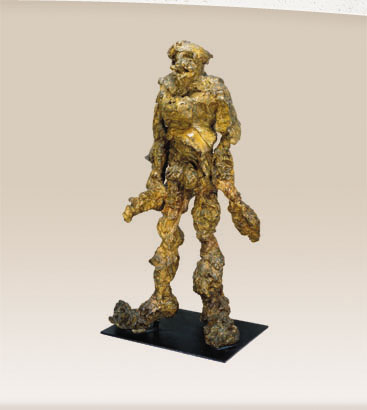View current page
...more recent posts
cuechamp recently posted a music mix titled "source code" [(76 min - 72MB - .mp3], consisting of the original songs--mostly from the '70s--that were subsequently, heavily mined for sampled drum breaks by hiphop and drum & bass producers. If you've listened to any music other than country (and maybe even that) for the last 25 years you will also recognize many of the piano stabs, vocal hooks, and random cowbells in these R&B, funk, and fusion classics (they were also very popular with house and garage producers). cuechamp doesn't layer or mash up the tunes: one song respectfully follows another in a nice flow that would also make it an excellent house party soundtrack. Here's the tracklist:
1. chase the devil - max romeo and the upsetters
2. amen, brother - the winstons
3. think about it - lyn collins
4. apache - incredible bongo band
5. ready or not - the delfonics
6. take me to the mardi gras - bob james
7. i'm gonna love you just a little more - barry white
8. shack up - banbarra
9. you can't hide from yourself - teddy pendergrass
10. scorpio - dennis coffey
11. fate - chaka khan
12. dance to the drummer's beat - herman kelly (I love this one -tm)
13. all this love that i'm giving - gwen mccrae
14. get out of my life woman - lee dorsey
15. far beyond - locksmith
16. ashley's roachclip - soulsearchers
17. i love you more - george duke
18. champ - the mohawks
19. praise you - camille yarbrough
20. funky drummer - james brown
It would be interesting to create graphs showing all the subsequent uses of sound bites from this "source code." If you sorted them by length you'd probably find the samples get longer in proportion to (1) the age of the track using the sample and/or (2) the economic strength of the samplee. This is because of an "invisible attractor" force in current creative endeavors called The Law. Early house and hiphop was made in the day before humorless poor sports like The Turtles started suing and winning cases for their precious string snippets. Nowadays the samplee becomes an involuntary creative partner in the new production, depending on the amount of lawyer fees he/she can afford (or recoup on contingency). Such issues are discussed in Lawrence Lessig's new freeware book, also linked to on cuechamp's page.
Here's a relevant quote pulled not from Lessig's .PDF but from a NY Times article about the Danger Mouse Grey Tuesday protest, before the article disappeared into the Times' proprietary vault:
Jonathan Zittrain, a director of the Berkman Center for Internet and Society at Harvard Law School, said the issue is indeed a gray one. "As a matter of pure legal doctrine, the...protest is breaking the law, end of story," Mr. Zittrain said. "But copyright law was written with a particular form of industry in mind. The flourishing of information technology gives amateurs and home-recording artists powerful tools to build and share interesting, transformative, and socially valuable art drawn from pieces of popular culture. There's no place to plug such an important cultural sea change into the current legal regime." (emphasis added)
More
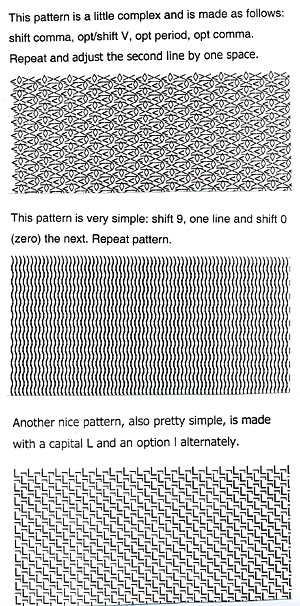
Peter Coffin, ASCII Weaves, from KnitKnit #2
Elliot Winard, iPod Cozy, also from KnitKnit #2
Virtual Craft Project
Make a needlepoint of the paperback cover image for William Gibson's collection Burning Chrome. See explanatory notes under pics below.
The above "video cyborg" by Richard Berry is très 1987 (but kind of good)--check out those Max Headroom stripes in the background. This is just a scan of a paperback cover, but my idea would be to contract out the sewing so that a detail would look like the image below (assuming anyone has about a year):
Nintendo Ocean, 1994, by Bill Davenport. This Houston-based artist had a ten year jump on a lot of the lowtech Komputer Kraft stuff that's going on now, with the Providence collectives and whatnot. He did go to RISD, but in the '80s. This 8.5" X 12" needlepoint was stitched by Olga Vanucci. Note: the image is cropped at the top and more cyan than the original. More needlepoints from this series are here (click on thumbnails for enlarged views), and a 2002 exhibition of Davenport's faux-lumpen sculptures and crafts, which I prefer to his recent trompe l'oeil book cover paintings, is documented here.
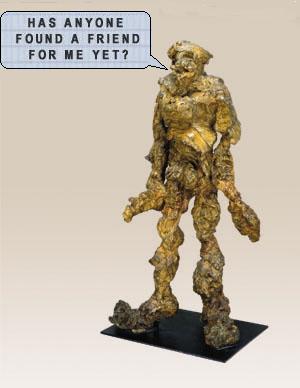
A new piece of music I made: "Eine Zwei Drei" [1 min - 1.37MB - .mp3]. I find it kind of sinister. Coming this soon after talking about Monotrona, it might be compared to that, but I'd say it's closer to Laibach. That's it--a kind of abject, basement Laibach (Slovenian dirge-y synth stuff, but this is goofier.)
Joe McKay's preReview, where yrs truly occasionally moonlights with trenchantly uninformed coverage of Hollywood crapola, was named "Unfortunate Site of the Week" by Time Out NY this week. Here's what they said: "Everyone's a critic--only some people think they're so smart they can review a film based on previews alone. Encourage them to get a life by not going to homepage.mac.com/joester5/prereview for 'prereviews' of soon-to-be-released films." This is what's known in the preReviewing trade as an "inverted psych maneuver" or the less technical "stroke'n'slap." Tell'em not to go and then give'em the URL, ri-iii-ght. Yet beneath that passive aggressive unplug you can smell the stench of fear hovering over a trade that knows its day is about over. I mean, these people expect you to shell out at the box office for a product you know you'll hate, and then plunk down coin AGAIN to read what they say about it. preReview on the other hand saves you both payments and is actually entertaining. So by all means, don't pick up Time Out NY this week to read their plug of McKay's site.
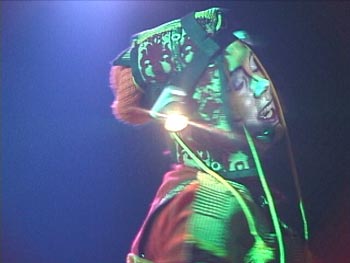
An earlier post described a "radio musical" I heard several years back by Electro musician and performance artist Monotrona (it might be called the first Electro opera.) I taped it on cassette and am now posting it here in all its hissy, lo-fi glory. [36 min, 33.6MB] Here's what I wrote before:
I first heard Monotrona on the Stork Club on WFMU-FM (a sadly missed live music show), around '97 or '98, performing "Joey, a Mechanical Boy,” which was described as the "fourth in a 14-section work called the 'Fourteen Imitations of Man.'" The story--told in music and dialogue, all performed by the artist using a variety of accents, vocoderlike filters, etc.--was extremely weird. Joey is an ectopically-spawned robot child who goes to work for NASA. His mother, in a ridiculous Chicago accent, tries to reach him on the phone and is headed off by the "Dark Technical Force," a gnostic demiurge that has a strange hold over Joey. Meanwhile, two shadowy government operatives discuss a rogue scientific scheme to create a ManWoman. The piezoelectric puppet show includes some really beautiful songs in the Chrome/Suicide/Throbbing Gristle postpunk vein, performed with buzzy, distorted keyboards. After the performance, Stork described Monotrona's equipment for listeners as "a mountain of unpatented cheap toy electronics adapted for her use--an indescribable array of electronics centered around a Casio machine, using light sabres, pistols, all sorts of mixers, and an oscillating device that looks like a little recipe box with two joysticks coming out of it..."Combining music and stand-up with the sheer Cage-ean randomness of these toy store electronics, "Joey" is brilliant even in a crappy, taped-off-the-radio recording. The bleeping, buzzing acoustics wed the arcade with the abyss, as Joey struggles to master simple digestive and muscular functions under the tutelage of a scary voice recalling Tron's Master Control Program. Monotrona is considerably more than just an entertainer or proto-Electroclash musician or what have you (although her recent songs are tight, smart pop): she is a poet of the "dark technology" embracing us whether we hug back or not. (video still from punkcast 237)
One More Half-Truth for the Road
Former White House Press Secretary Ari Fleischer has a letter in the New York Times today, attempting to set the record straight on a creepy statement he made in the immediate aftermath of 9/11/01. Read it carefully:
In "Lifting the Shroud" (column, March 23), Paul Krugman alleges that at my White House press briefing on Sept. 26, 2001, I "ominously warned" Americans to "watch what they say, watch what they do." He accuses me of telling citizens "to accept the administration's version of events, not ask awkward questions.""They're reminders"--meaning both the statement by the racist congressman and the Maher statement. Nice try, Ari.At that briefing two weeks after Sept. 11, I was asked about a racist comment made by a Republican congressman from Louisiana who said that if he saw a Sikh-American with a towel wrapped around his head, he would tell the Sikh to get out of his state.
I said, "It's important for all Americans to remember the traditions of our country that make us so strong and so free, our tolerance and openness and acceptance." The president, I said, was disturbed by Representative John Cooksey's remarks.
Moments later, I was asked about Bill Maher's statement that the members of our armed forces who fire missiles are cowards while terrorists who crashed planes into buildings are not cowards.
I answered: "It's a terrible thing to say, and it's unfortunate. And that's why — there was an earlier question about has the president said anything to people in his own party — they're reminders to all Americans that they need to watch what they say, watch what they do."
My remarks urged tolerance and openness and were addressed to those who made statements and threatened actions against Muslims or Sikhs in America.
ARI FLEISCHER
Washington, March 23, 2004
The writer was White House press secretary from 2001 to 2003.
UPDATE: To make his argument work, even though it doesn't, Fleischer also has to paraphrase Maher's comments. Here's an excerpt from an article giving the context of what Maher said:
Of course, all this was said before President Bush put soldiers in harm's way with an unnecessary land war--forcing them to prove their courage on the ground. The article doesn't mention that Maher groveled to try to save the show, or that there was another prominent dissenter--Susan Sontag--who got slimed around the same time.In the weeks after September 11, critics wondered how late-night talk shows would change. Predictably, Leno and Letterman told fewer and safer jokes, mostly at the expense of easy targets like the Taliban and Osama bin Laden. The Daily Show's Jon Stewart was so shaken he cried. But Politically Incorrect, true to form, crashed the somber late-night party. Appearing on Sept. 17 for the first show since the attacks, Maher made it starkly clear his show would live up to its name.
"I do not relinquish - nor should any of you - the right to criticize, even as we support, our government," Maher said. "This is still a democracy and they're still politicians, so we need to let our government know that we can't afford a lot of things that we used to be able to afford. Like a missile shield that will never work for an enemy that doesn't exist. We can't afford to be fighting wrong and silly wars. The cold war. The drug war. The culture war."
What Maher said later in the show, however, is what made headlines. Panelist Dinesh D'Souza [a young conservative --ed.] mentioned that he didn't think the terrorists were "cowards," as George Bush had described them. Maher replied: "We have been the cowards. Lobbing cruise missiles from two thousand miles away. That's cowardly. Staying in the airplane when it hits the building. Say what you want about it. Not cowardly. You're right."
Res Ipsa Loquitur
While I'm getting a bagel this morning I see a photo of Secretary of Defense Donald Rumsfeld on the front page of a local newspaper, testifying before Congress. His hands are raised in a weird gesture, half-imploring, half balling his fists, his mouth a rictus of mock-agony. "Even if bin Laden had been captured or killed in the weeks before 9/11, no one I know believes it could have prevented 9/11," the caption has him saying. The same day, President Bush said, "Had my administration had any information that terrorists were going to attack New York City on September the 11th, we would have acted." These statements make 9/11 sound like an inevitability, a work of subtle genius that no one could have stopped or anticipated.
But think about it--how subtle was it, really? 19 terrorists pass airport security, four planes are hijacked from three different locations, three planes reach their targets, one of which is the military command center of the United States. No fighter jets intervene during their copious flight time. In law, there is an expression "res ipsa loquitur" (the thing speaks for itself), as when a surgeon sews up a sponge inside someone's body after operating. Meaning, this is the type of thing that would never happen absent negligence. 9/11 is one of those events. And yet no one, not one person, has been fired. The dissemblers in the Administration think if they refer to it often enough as an unpreventable, act of God-like event, people will be worn down and start to disbelieve their own common sense about it.

Speaking of the Middle East and Star Trek, the picture above of the late, soon-to-be-blown-away Sheik Yassin (from the New York Times, looking much like a waxwork from Madame Tussaud's) made me think of Captain Pike:

Which reminded me to look for a cybertheory essay I read years ago, by Alan Shapiro, called "Captain Kirk Was Never the Original." Lo and behold, I found it, and commend it to your reading. In a nutshell, Shapiro contrasts Kirk's Cartesian man of action with Pike's traveler in virtual reality, suggesting that we "read Star Trek against Star Trek" rather than dismiss it, as many theorists do, as a relic of pre-digital consciousness. Here's a good excerpt:
The successful media product model has as prerequisite a mythical moment of transcendent creativity which clears the way for the emergence of a new spectacle object. The spectacle object (celebrity, consumer gadget, media property) then enters the panoply of fetishes among which we shop in our efforts to find an identity "niche" and dubiously distinguish ourselves from others. The model serves as lightning rod for ambivalent collective projections, allowing each individual to feel unique at the very moment when all consumers of that same niche are imitating the same elevated pattern.And another cool passage:
But the fully achieved simulacra of virtual reality threaten the stability and profitability of this system of differences. This is why Captain Pike, who was too far ahead of his time, had to be shunted aside in favor of the valorous Captain Kirk.
So Pike, the true first-born, was whisked away into virtual reality and replaced by the changeling Kirk. There was, of course, another way forward for Captain Pike, but the screenwriters of "The Menagerie" were unfortunately ignorant of the basics of writing operating systems software drivers for peripheral devices. Since Pike's bio-rehabilitation programmers had succeeded in resuscitating at least one controllable nerve impulse from his consciousness, and connecting the discrete signals of this impulse across the synaptic gap to an output device (the beeping for "yes" or "no"), further layers of software to drive more sophisticated output devices and sound cards would certainly be possible. From the single binary registering of a 0 or a 1, an entire operational language (a full digital communication) can be devised. One merely has to enumerate and combine varied sequences of 0s and 1s as discrete identifiers in an infinitely permutated system. The only drawback would be that Pike's consciousness itself would always remain at the level of the lowest machine language, forced to perpetually master and will the lengthy binary sequences in order to express himself! He would literally be the machine and its finally awakened artificial intelligence.
| Who Dares Disturb My Slumber? *cue eerie theremin sounds--figure comes towards you slowly in FLASH animation--surfers faint dead away at their keyboards*
SEE IT TODAY1 at the Nasher Sculpture Center2 website, a Flash-and-popuphell extravaganza declared by this weblog to be Gratuitously Dynamic Website of the Week.3 1. Okay, there's no theremin, but the figure does come towards you from the back of a "virtual gallery" in dramatic, ever-enlarging stages. The sculpture, Willem de Kooning's Clamdigger (1972), introduces Abstract Expressionist subjectivity to the human figure in three dimensions and is one of Count Floyd's favorite artworks.
2. Housing the Raymond and Patsy Nasher sculpture collection, Dallas, TX. 3. This weblog is not responsible if you become lost in the Nasher site and are unable to navigate back to this URL. Thanks to Bill Schwarz, who inadvertently provided this target. |
Beige Programming Ensemble at the Whitney; The Slowes
I missed Cory & Jamie Arcangel and the Beige crew at the Whitney last night because I had to w_rk, but fortunately Thickeye is on it with an excellent report. I like his description of the line of kids wrapped around the block for free admission night, soon to be groping in the darkened video rooms, contrasted with the image of middle age people sitting at tables in the downstairs dining room, politely listening to the Beige-rs explaining their new 8-bit iPod concept.
Beige has a music download page that I highly recommend, consisting of their vinyl releases in mp3 format. Cory also recorded several songs as The Slowes, which I am pleased to offer here. The melodies are faux-dumb and very catchy. I say faux-dumb because they're actually fairly ambitious in terms of musical reach--a lot of pop music history is integrated in them (lounge, 60s-electronica, progrock, Pink Floyd...). The lo fi-ness keeps the homages from being overt or too reverent. Here's how Cory explains them in an email (edited slightly):
yeah,...the slowes is just me. most of the melodies were written by a melody writing program i wrote called "Rudy Tardy Generator Pro"..it was a cgi script. every time you went to its web page, it generated a new song and melodies (in the slowes style, which is lotsa open roller rink kinda chords) so....... i would have the program spit out 10 melodies...i would then pick the best few, turn them into a song, and go into my bedroom and record them. i used an organ, atari, drums, + guitar////The Slowes downloads:the whole myth of the slowes that I made up was that it was this guy who sat in his basement all day and worked on his atari. his name was Rudy Tardy. This was his band. For a few years, i used Rudy Tardy to sign all my art projects...[Beige recording artist] Paul [B. Davis] to this day still Dj's under the name DJ Rudy.
"Fat Bits" [.mp3 - 1.33MB]
"Starship Izod" [.mp3 - 4.12MB]
"The Anthem" [.mp3 - 2.29MB]
"Hooked on a New Thing" (cover of 3Nuff Z'Nuff) [.mp3 - 5.2MB]
Suite: All Four Songs Above [.mp3 - 13.14MB]
Wow. The March 14 Mercury News story about the Fresno polygamist child murder that Atrios originally linked to has been extensively rewritten (see my previous post about all this). I went back to look at it because it described policemen carrying dead children out of the house and weeping, and quoted a police chief holding back tears, saying "this sort of thing doesn't happen in Fresno" or the like, and was very slim on details of what actually happened. The police reactions seemed pretty over-the-top (even for such a tragic crime) and I wanted to reread the account, in light of allegations that the cops had negligently given Wesson time to go into the back of the house and shoot the children while the gendarmes stood on his doorstep, ignoring the pleadings of relatives who knew what Wesson was capable of. Well, all that detail about the crying cops is gone from the story, sucked down the memory hole, and Fresno Police Chief is suddenly dry-eyed, in control, and quoted as saying "what happened at the house is under the investigation." So much for an independent press--obviously this story was rewritten to placate the authorities. Nowadays you have to save every story you read to your hard drive. (A copy of the rewritten story is here.)
UPDATE: It looks like the article was rewritten several times after publication. Mark found another version, posted in the comments.
UPDATE 2: Mark found the "crying, child-carrying cops" version I read, slightly differently worded, on the Mercury News website, as an AP story dated March 13, under a different byline. So it's not down the memory hole (yet). I really do wonder why the article was rewritten several times, omitting more and more detail each time about the emotional state of the cops.
So far, Atrios called it correctly when he predicted, on March 14, that "the horrible case in Fresno, where a man...allegedly slaughtered his 7 children, [will get] about 1/50th of the media coverage that the Andrea Yates case did." Andrea Yates, you will recall, had a history of depression and drowned her five kids; she's now doing prison time while her fundamentalist Christian husband has remarried. Alleged cult weirdo and woman-controller Marcus Wesson has been charged by the Fresno police with shooting his seven kids and two grandkids and stacking their bodies in the back of his house, which had ten coffins in it; he is believed to have fathered the grandkids by impregnating two of the now-deceased children. Sure enough, it looks like the latter is being treated as "local news" and we won't be hearing much more about it. Atrios doesn't spell out why he predicted what he did, so please allow me to state the obvious: Wesson is a man and has the right to sire as many children as he pleases and then destroy them at his whim, while Yates is a woman and has no greater duty than the sacred trust of child-rearing. The media knows this; everybody knows this. That monster, how could she? I'm getting all upset just thinking about her case again.
UPDATE: As Barry mentions in his comment, Wesson is black and Yates is white, which may also have something to do with the disparity in coverage. A Seventh Day Adventist, Wesson lived in a reasonably affluent neighborhood but no one ever really asked what he and all those women dressed in black were doing with the schoolbus parked in the driveway (transporting coffins, among other things). Control freak to the core, he allegedly murdered the children when he became convinced the authorities might take them away from him. Hardly any ingredients of a national story here.
UPDATE 2: The story has picked up unexpected juice with the revelation that the Fresno police may have been cooling their heels at Wesson's front door while Wesson went into the back of the house and shot the children. "Fresno's police chief acknowledged Wednesday that his department is looking into whether Marcus Wesson fatally shot nine of his children while police waited outside his house, despite frantic pleas from relatives to intervene." (CNN). The google count on "Marcus Wesson" jumped from 9000 to 11,000 since this morning.
UPDATE 3: The newspaper account of the Wesson arrest was rewritten several times after publication. More here.
From the NY Times today:
A defiant Supreme Court Justice Antonin Scalia refused Thursday to remove himself from a case involving his good friend, Vice President Dick Cheney, dismissing suggestions of a conflict of interest. In an unusual 21-page memorandum, he rejected a request by the Sierra Club. The environmental group said it was improper for Scalia to take a hunting trip with Cheney while the court was considering whether the White House must release information about private meetings of Cheney's energy task force. Scalia said the remote Louisiana hunting camp used for a duck hunting and fishing trip "was not an intimate setting." [...] For the first time, Scalia revealed details of his trip with Cheney. Scalia said he was the go-between to invite Cheney to hunt with a Scalia friend, Wallace Carline, who owns an oil rig services firm, Scalia wrote. Scalia and Cheney are friends from their days working in the Ford administration, Scalia noted. "I conveyed the invitation, with my own warm recommendation, in the spring of 2003 and received an acceptance," Scalia wrote. When the time came for the trip, Scalia and Cheney flew together, accompanied by one of Scalia's sons and a son-in-law, Scalia wrote.Got that? The hunting trip was OK because (1) Scalia and Cheney were chaperoned and (2) the trip was really about Cheney getting together for some male bonding with an oil industry tycoon, and Scalia just hooked the two up. These people are so deeply in bed they expect normal people to think rules of etiquette like "avoid the wet spot" means "never met the dude."
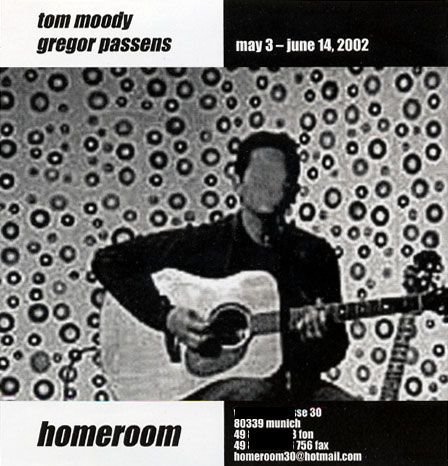
I'm finally getting around to scanning the ad that ran in Artforum for my Munich show with Gregor Passens in May 2002. It's pretty murky, but the source image originally came off the internet and it's been copied umpteen times. The guitarist is a semi-famous musician who played at the Aldrich Museum, where my sphere piece was installed, using the piece as an impromptu backdrop. It seemed reasonable to borrow his guitar-playin' bod for my ad, with his face eradicated to avoid "likeness rights" issues and as an homage to Boards of Canada. homeroom director Courtenay Smith is currently the curator at lothringer dreizehn, a Munich art space that is opening a new show this weekend, "Changing Rooms," featuring the work of Monica Kapfer, Aylin Langreuter, Martin Schmidt, and Tom Früchtl.
Ender's Game, by Orson Scott Card, is a fascinating book and an enjoyable guilty read for antiwar types with a passing interest in things military (I'm describing myself here). Nevertheless it's flawed and also kind of sick, and its cult in the military should be questioned. Here's a quick, dashed-off criticism for anyone who hasn't read the book.
(1) The book envisions a society shaped by years of war against a relentless enemy from space. The government is coldly totalitarian and kids are watched for special aptitudes and recruited at like, age 6. Family members are pitted against each other in competition for coveted slots in the military.
(2) The military training passages are well-imagined and I can see where they'd be useful in educating troops in a total-war mindset. But they're kind of gratuitous in terms of the plot, since Ender ultimately saves the world not through bonding with his buddies but with his solitary videogame-playing skills. More than one critic pointed out that the book, which came out in the early '80s, flattered the adolescent reader who was spending a lot of time hanging out in arcades.
(3) Card, the author, is a practicing Mormon and, just like our President, thinks in terms of Absolute Good and Absolute Evil, so a plot like this is not farfetched to him, but it's still an escapist fantasy, and to imagine we have enemies as implacable as the Buggers from outer space just plays into the neocon propaganda line.
(4) Gratuitous editorial: A strong, well-trained military is of course necessary when your country is threatened militarily. But otherwise, it's a dangerous thing to have because then you feel like you have to use it. Thus, you send it off periodically to keep it in trim conquering weaker countries (always in the service of humanitarian goals, of course).
(The above comments originally appeared on Jim's page, about a year ago, right after the Iraq invasion was launched and bombs were bursting in the air. I'm reprinting them here as a kind of tribute to a former co-worker who joined the Marines thinking he was going to be doing "communications" and is about to be shipped over to you-know-where.)
A few quick unrelated items: (1) dan at erase reports on a Squarepusher/Steve Reich/Aphex Twin-related live gig in the UK that sounds like a lot of fun. He's also been posting links to good online mixes, such as this
 tech-house assortment [since removed--"Eucalyptus" and "Night Herbs" were the ones I recommended] and this 80s/00s electro jam. (2) The Doris Piserchia Website has been updated with a sample chapter from her 1981 novel Earth in Twilight, and a review of that novel reprinted from Nathan Shumate's website. (3) A friend lent me his Cowboy Bebop series DVDs, which are fairly mindblowing. In the .GIF at left, bounty hunter Spike is opening the Bebop airlock so he can push a refrigerator out into space. He left a lobster in there a year before and it mutated into a blue springy thing that escaped and bit all of his shipmates and put them in comas. More horrible stuff was breeding in the icebox, hence his need to space it. And his skin isn't really yellow-green except in a 16-color .GIF.
tech-house assortment [since removed--"Eucalyptus" and "Night Herbs" were the ones I recommended] and this 80s/00s electro jam. (2) The Doris Piserchia Website has been updated with a sample chapter from her 1981 novel Earth in Twilight, and a review of that novel reprinted from Nathan Shumate's website. (3) A friend lent me his Cowboy Bebop series DVDs, which are fairly mindblowing. In the .GIF at left, bounty hunter Spike is opening the Bebop airlock so he can push a refrigerator out into space. He left a lobster in there a year before and it mutated into a blue springy thing that escaped and bit all of his shipmates and put them in comas. More horrible stuff was breeding in the icebox, hence his need to space it. And his skin isn't really yellow-green except in a 16-color .GIF.UPDATE: The mixtapes mentioned above are by Sami Koivikko, from Finland, who makes tracks when he's not dj'ing. The "Night Herbs" mix is flawlessly beat-matched and contains a number of those angelic arrangements of 3 or 4 confectionary notes that probably have a more precise musical term but are what I like most about house tracks, especially of the minimal/tech variety. Producers such as Losoul, John Tejada, Paul Kalkbrenner and other favorites are included in the mix.
How cool is it that the people of Spain reacted to the terrorist attacks in Madrid by firing their right-wing government? And that the new government plans to bring the country's troops home? Let's do that here! Unfortunately we have to wait eight months before we can get rid of George Bush Jr., whose crappy leadership the Spanish have also implicitly rejected. Or maybe we don't--for the crime of lying us into war with the wrong country (and general all around corruption), how about impeaching the perpetrator? To get an idea of how bad things are over in Iraq--our tax dollars at work--please read Robert Fisk's one year recap. Here's the plan: send Bush back to the Midland Racquet Club, then pressure Kerry to end the occupation post haste. After paying reparations, we'll only be out a few hundred billion for our little adventure.
If you are a fan of Jonathan Lethem's novel Motherless Brooklyn, here's bad news for you. Sit down, have a drink, please don't bite my head off when I tell you. OK, here goes: it's being made into a film written, directed, and starring Edward ("Fight Club") Norton as Lionel Essrog, the detective with Tourette's. Oh, yeah, and it's being "loosely adapted," according to Norton's website (which I'm not linking to) to be "set in the 1950s." If you're wondering why that's bad, I mean good, please read my preReview. And while you're there, check out all the new preReviewers: since the site was last plugged here, it got listed on memepool and a bunch of "cool site" indexes and its traffic went up into the stratosphere. It is now the Internet Phenomenon this page always said it was. Joe McKay, the editor, is tooling around Gotham in a Lincoln town car, smoking Te-Amo Toro Lights, and has taken to wearing a pinky ring.
I still haven't finished Lethem's "Great Book," Fortress of Solitude. The idea of revisiting 7th and 8th grade (and summer camp!) with him, even with adult hindsight, is just too grim. The last passage I read, describing a Brooklyn street party where he's the only white kid, rang false somehow, even though the book is based on his own childhood: it read more like pop culture research than something that actually happened to anyone. Let's pray he goes back to writing intellectually suspect fiction and stops believing his own hype about being the "poet of Brooklyn" or whatever.
A book you should read, though, is Takedown, by Rick Cowan and Douglas Century. Cowan is the undercover cop who singlehandedly broke open the Mob-run garbage-hauling cartel that cheated New York businesses for 50 years. Like many people, I believed the spin that it was District Attorney Morgenthau and the out of town corporate criminals at BFI who did the hit--the book is partly to set the record straight. Until Cowan infiltrated the Mafia, at the highest levels, pretending to be an executive with a DUMBO paper recycling company, every building in NY had to pay up to ten times market rates to have their trash hauled away. The book gives an excellent history of how those conditions came about, and is as gripping and amusing as a Sopranos episode in its retelling of Cowan's story. I laughed, I cried, I broke up with my goombah 'cause I couldn't put it down.
Chelsea NYC suddenly feels like a giant actor's workshop, not that that's bad. Wander around the 20s and you'll see performance videos as entertaining as movies and TV (no, really!) but several steps removed and looking askance at the conventions of the Industry: a kind of Deconstructo-Sundance. At Sonnabend Candice Breitz shows discontinuous loops of emotional scenes from chick flicks such as Pretty Baby, You've Got Mail, and...um, that's all I recognized, while at the same time lip-synching and pantomiming the actresses' moves. She's a good mimic, capturing everything from Jennifer Lopez's wooden blubbering to that subtly self-aware Commedia del'Arte eye-pop when Reese Witherspoon says "You're breaking up with me? I thought you were going to propose!" (Note to self: rent Legally Blonde sometime.) At Elizabeth Dee, Alex Bag shows the famous, weirdly affectless P4r1s H1lton s3x t4pe intercut with fake commercials, where Bag impersonates everyone from a bearded AOL websurfer to a graveyard zombie hawking maxipads to Private Jessica Lynch pitching Halliburton services from a teleprompter--badly. Political satire has gotten better since the dazed "you can't say that, this is wartime" days. Lastly, at Mary Boone, Barbara Kruger, the Don Rickles of the art world, casts obvious LA residents as talking heads abusing one another from across the room, on large screens corresponding to each head's position at some kind of eating table (restaurant, dining room, school cafeteria, breakfast nook). Artists, filmmakers, families, couples, students--everybody's pissed at each other in Babs' world. The dialogue is funny, though. Hey-oh.
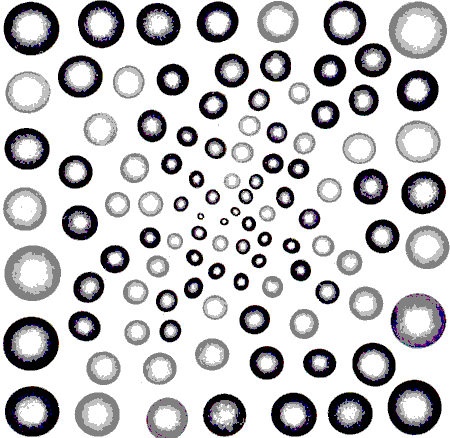
Crap houses
Here's what I dislike about the tech/geek/art community, as exemplified by the Eyebeam "reBlog." reBlog is a bunch of recycled links from a particular group of bloggers, curated by a single individual down to a coolest-of-the-cool selection. Fine, so far, but there's very little in the way of text, thought, or explanation here--just feeding the endless craving for (mostly tech) novelty. So, I see this item culled from boingboing captioned "Print houses from CAD drawings using an adobe-extruding robot." I'm not completely following this. [If I'm not mistaken, the reBlog post has since been slightly expanded.] I click the link and learn more about an aesthetic nightmare waiting to be born, which we're supposed to think is great, I guess:
A robot for "printing" houses is to be trialled (sic) by the construction industry. It takes instructions directly from an architect's computerized drawings and then squirts successive layers of concrete on top of one other to build up vertical walls and domed roofs.You know what that sounds like to me? That sounds like shit. Frank Gehry meets Planet of the Apes. Besides throwing tradesmen out of work (yeah, I know, boo hoo, progress marches on), it has the potential to turn the construction industry into McDonalds, shitting out thousands of McHouses, McFlats, McMalls, and McOffices. And, it violates what ought to be Rule One of fusing technology and the arts (including architecture): "You shouldn't do something just because you can." How about a little criticality here, art/tech people?
UPDATE: Bill Schwarz has another link on the "extruded house." This one doesn't look like Planet of the Apes, more like the stone slave huts they put up in the Caribbean years ago for people working in salt ponds and the like. And sure enough, the obligatory quote: "It's hard to imagine construction unions taking this lying down, and union opposition is expected. But [P]rofessor [Khoshnevis, the inventor] points out that we are moving towards a society in which just about everything else is fabricated by machines. Why should houses be different, he asks?" Yeah, why? Nasty damn unions, always getting in the way of capitalist innovation.
UPDATE 2: Post edited slightly so I sound like less of a Luddite, if that's possible. Jim has a good response to my outburst in the comments.
UPDATE 3 (Feb 2005): I take back everything I say about the Eyebeam reBlog since they were kind enough to indulge my tech-skepticism by inviting me to guest reBlog for a few weeks.
Cry Me a River, Tim and Sue
Tim Noble and Sue Webster, YBAs (Young British Artists) who recently showed at PS1 here in NYC, are known for three types of work: a sculpture of male and female Neanderthals reminiscent of Ron Mueck's sentimental output, flickering Vegas-y light pieces, and collections of odd rubbish that cast figurative shadows, a trick that Mac Adams, an OBA (Old British Artist, but living/showing in the States), has been working with for years. The pair is profiled in this month's Sculpture magazine, and as the following excerpts make clear, they want us to know they have problems:
Noble: "When we first started doing [the light pieces], to us, they were aesthetically insulting. You were supposed to...be confronted by them 10 feet in front of your face... [B]ut as time goes by and they get photographed more and more, you don't get the closeness. You need that slap in the face.The last two quotes were interspersed with the usual protestations that they've taken their career "off the rails" and are no longer on the "roller coaster"--as they move from MOMA affiliate PS1 to the Museum of Fine Arts in Boston. Ah, humility.Webster: "We take reproductions very seriously so that the work can be documented and find its place in history."
Webster: "When you are young and starting out you have nothing to lose, you are alone in the studio making work and no one is looking. But then you get exhibited, and the ball starts rolling: you get booked for shows and everyone wants a piece of you. Then they try to determine when you finish the work. You can get drawn into the system, where you'll have a show in London and then one in New York, and someone says when the work gets made and even tries to influence what it is that has to be made."
Webster: "We get offers every day from people who build their careers around us. You, as an artist, are actually just producing a feed in the system. They harass you to take part in some project because it is all about them. We have to be aware of that because we could have our careers tied up for the rest of our lives producing one show and then another, but the reason we are artists is not to be part of this system."
The critical consensus about Mel Gibson's hugely popular Jesus movie (over $200 million in box office and it's only the second weekend) is that it's a sustained exercise in audiovisual pain: why just lower the crown of thorns onto Christ's head when you could pound it into his scalp with a hammer? There's a centuries old tradition of depicting this kind of suffering, especially in painting and sculpture, which frankly I'd rather read about than see reenacted in Dolby Surround with the latest special effects technology. Alex Wilson discusses the "Man of Sorrows" tradition of devotional images here, particularly those of Albrecht Durer, who did what you know Mel wanted to do and probably would have done if he'd been Rich Mel rather than Mad Max 20 years ago: cast himself as Jesus. ionarts has some additional, interesting historical detail on another famous Man of Sorrows, the one in Matthias Grünewald's Isenheim Altarpiece, discussed here earlier. I first learned about the latter work reading J.-K. Huysmans' grueling description from his occult novel Là-Bas. This is art criticism at its most committed and unstinting; Mel's got nothing on this account.
"Purulence was at hand. The fluvial wound in the side dripped thickly, inundating the thigh with blood that was like congealing mulberry juice. Milky pus, which yet was somewhat reddish, something like the colour of grey Moselle, oozed from the chest and ran down over the abdomen and the loin cloth. The knees had been forced together and the rotulae touched, but the lower legs were held wide apart, though the feet were placed one on top of the other. These, beginning to putrefy, were turning green beneath a river of blood. Spongy and blistered, they were horrible, the flesh tumefied, swollen over the head of the spike, and the gripping toes, with the horny blue nails, contradicted the imploring gesture of the hands, turning that benediction into a curse; and as the hands pointed heavenward, so the feet seemed to cling to earth, to that ochre ground, ferruginous like the purple soil of Thuringia.
"Above this eruptive cadaver, the head, tumultuous, enormous, encircled by a disordered crown of thorns, hung down lifeless. One lacklustre eye half opened as a shudder of terror or of sorrow traversed the expiring figure. The face was furrowed, the brow seamed, the cheeks blanched; all the drooping features wept, while the mouth, unnerved, its under jaw racked by tetanic contractions, laughed atrociously.
"The torture had been terrific, and the agony had frightened the mocking executioners into flight.
My review of the "Paradise/Paradox" exhibit at the College of New Rochelle, curated by Susan Canning, appears in the March issue of Sculpture magazine (print edition only). Here's a sample paragraph:
The three-dimensional work in the show is a curious mix of the hopeful, the cautionary, and the misguided. Recalling a 1950s model kit for high school biology students, Michael Joo’s Small Vitrine, 2000, presents a seated Buddha in clear cast plastic, with plastic bones and internal organs completely revealed. Conspicuously absent is the Holy One’s head, perhaps reflecting the ancient Zen wisdom that it’s the body part that gets us into the most trouble. And as if to prove Joo’s point, Colin Keefe shows us an overdetermined idea of Heaven, 2001, a seven-foot-tall model of a gyroscope-shaped space colony, which perpetuates, out among the stars, many of the foibles of 20th Century urban planning. On the inner surfaces of this partial Dyson sphere, living space in the form of hundreds of densely clustered high-rise buildings is segregated on two of the rings while the third is empty greenbelt. Another work of Keefe's, a drawing on a nearby wall, shows a series of barricaded enclaves separating city-dwellers from what appears to be unoccupied land. Yet if it‘s truly empty, why have the barricades?1 Finally, Jason Middlebrook mocks present-day notions of heaven on earth with an entropic, post-apocalyptic re-envisioning of Frank Gehry’s Guggenheim Bilbao design. The artist gets revenge on a pretentious architect by imagining the building partially collapsed, surrounded by weeds and rubble, and festooned with graffiti. (minor changes made in response to an editorial change to the original text)Below is the image of the Middlebrook piece that accompanies the review, Guggenheim Bilbao, Part II (2002, wood, paint, polystyrene, 34.25 x 52 x 39 in.). Behold Gehry's creation, as it deserves to be remembered:
1. No one seems to be sure what's going on in Keefe's work, exactly. On the reviews page on his website, Holland Cotter says it picks up the pieces of discarded utopian design, while Gary Michael Dault in the Toronto Globe says in so many words that it's winsomely dystopian. I'd say it's just plain dystopian.
UPDATE: The full text of this review is now online here.
A memorable book review on the (lamentably dormant) Strange Words website, titled "Charles Platt, Fun Interviewer" warns us about the Wired scribe's published conversations with famous science fiction writers, Dream Makers (Vols. I and II): that they are full of "creepy voyeurism," and that "Platt seems hell-bent on exposure, rather than the context of a writer's life." I just read my first Platt interview, with A.E. Van Vogt, and boy, they weren't kidding. Van Vogt comes off as a wacko, bore, and self-diagnosing Dianetics disciple, which he was, perhaps, but his fiction is really Out There and he deserves better treatment.
Van Vogt was one of editor John W. Campbell's "Big Three" writers, along with Arthur Clarke and Robert Heinlein. While the latter authors specialized in "hard" sf, Van Vogt was the visionary, specializing in tales of superhuman races and bizarre, alien logic systems. The basic plot of the movie Alien came from Van Vogt's story "The Black Destroyer," incorporated into the novel Voyage of the Space Beagle (after Darwin's HMS Beagle), a larger epic that, 16 years before Captain Kirk, told of a starship Seeking Out New Life and New Civilizations in the galaxies. The chapter where the catlike, tentacled horror is taken aboard the ship is here, and worth a read. Yes, it's pulpy, but it moves at a furious clip, introducing the players and political tensions on the vessel without letting up on the chills for a moment--even during a scene of explosive action. (It does everything but tell you what "Nexialism" is.) Van Vogt describes learning to write from intensive, obsessive study of a single how-to book, and the prescriptions for narrative economy and drive can really be felt in this passage.
Before Platt pulls out the big hatchet, he quotes Van Vogt talking about his own writing "system":
"In science fiction you have to have a little bit of a 'hang-up' in each sentence. Let's suppose, for example: The hero looks up toward the door." Van Vogt gestures toward the sunlit screen door of his living room, leading out onto the veranda. "He hears a sound over there. And something comes in. It looks like a man wearing a cloak. You don't quite know what's going on. Then, you realize this is not a human being. This creature or this being, whoever it is, has a sort of manlike shape. And this creature reaches into what now looks like a fold of its skin. It draws out a gleaming metal object. It points it at you. Is this a weapon? It looks like a weapon, but you don't know that for sure. It's a 'hang-up,' you see. The author furnishes the information, but each sentence in itself has a little 'hang-up' in it."
As he has been talking, almost hypnotically, with an eerie gleam in his eye, he has created such a mood of menace that, for a moment, the California sunshine seems less bright and the dreamlike description is nibbling at the edges of reality. He would say, perhaps, that this is through the power of his system, but I think it has more to do with the power of his personality and his intuitively shrewd choice of words and images. A system on its own is dull and mechanical, without inspiration to fuel it.

Panel from Hayao Miyazaki's Nausicaä of the Valley of the Wind (Vol. 4) - Hand-(re)drawn on Wacom tablet
As promised, here's the 2-Step Garage Mini-Mix: [.mp3 removed]. By way of background, this music combines the trickier rhythms, vocal science, and hiphop atmospherics (e.g., sped-up scratching) of drum & bass with the party vibe and divas of UK garage (a house variant). You may recall Ishkur (now in V.2!) called 2-Step "so fucking boring," complaining about its "idiotic" basslines and all the guest popstars. He's right about the guests: usually an electronic dance producer jumps the shark when vocals are added (see Swayzak, Chemical Bros.). But the basslines kind of crack me up. They make me think of the original intent of the Roland TB303, which was to be a kind of automated "bass genie" for pubrockers. The three tracks in this mix are light on vocals, guest or otherwise, and heavier on the atmospherics. All are "classic" 2-Step, meaning about 4 years old: "Scrappy" by Wookie, "True VIP" by Youngstar, and "Romantic Call" by DJ Deller. Any help with what the singer's saying in the last (after the lines "I'm on a romantic call/Talking to my baby down at the yard") would be greatly appreciated.
To the extent Mel Gibson's ego, I mean, faith, is forcing us to think about The Christ right now, you could do worse than looking at ionarts' rundown of the art historical Jesus (like, seeing Gibson's movie). Something I learned about Matthias Grünewald's beautiful, take-no-prisoners altarpiece:
That work was made for a hospital run by an order of monks whose mission was to serve people who were in terrible pain, especially those who had lost limbs. The fact that Jesus chose to die in one of the most painful ways possible, it was thought, is a consolation to a person in pain. In that sense, there is no particular reason, either religious or artistic, to sugarcoat the details of what Jesus suffered.
Below, a new .gif from my Animation Log.

Cintra Wilson's report on the Oscars is super-catty as always but worth a read (Salon subscriber-only text liberated here).
Janet Jackson ruined tits for everyone, so the vast majority of dresses were strictly Mormon prom. Even Elvis Costello wore a plain black jacket, for The Christ’s sake. Nobody even had interesting new plastic surgery, apart from Joan Rivers, whose face looks like it was gnawed out of marzipan by the savages of Easter Island, and Angelina’s Billy Bob-shaped laser scar.Damn. Don't ever make this woman mad at you. Her takedown of Seabiscuit (among other nominees) is more abstractly brutal, but still great:
"Seabiscuit" was a stink-pony – superclean schlock from nose to bumper. Spare me the sight of quaint, depression-era crowd scenes that look like they’ve been swaddled in tweeds by J. Crew, surging in rapture to majestic life-insurance violin orchestrations. That shit was strictly for Burl Ives, Pepperidge Farm and creamy ranch dressing.






